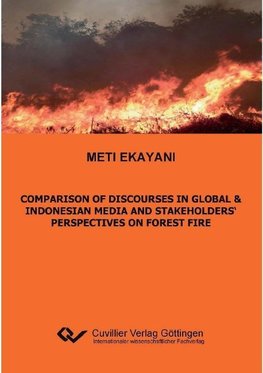
-
 Anglický jazyk
Anglický jazyk
Comparison of Discourses in Global & Indonesian Media and Stakeholders' Perspectives on Forest Fire
Autor: Meti Ekayani
This study focused on examining forest fire discourses in news media (global and national media), scientific media (international and national journals) and stakeholdersÆ perceptions (international, regional, national, and local organizations). There are... Viac o knihe
Na objednávku, dodanie 2-4 týždne
36.27 €
bežná cena: 40.30 €
O knihe
This study focused on examining forest fire discourses in news media (global and national media), scientific media (international and national journals) and stakeholdersÆ perceptions (international, regional, national, and local organizations). There are several important tasks of this study, i.e. understanding the interest position of actors by investigating common and different features of forest fire discourses in media as well as stakeholdersÆ perceptions; examining imbalance perspectives between national and global media discourses; evaluating the role of scientists in influencing policy-making process; and identifying asymmetrical perspectives concerning forest fire issues in media discourses and stakeholdersÆ perceptions. Several common features of forest fire discourses in the national and global media were identified in this study. It could be generally concluded that the issues of forest fire in media as mediality were very important in the media discourse. Besides, ômediaö, "administrations" were also frequently referred to speaking actors of forest fire discourses. According to the voice of speakers in forest fire discourses in the national media, ôadministrationsö such as ministers, regional environmental board, forest services, and nature conservation offices were mostly positioned as helper of problems. Consequently, the actors positioned as ôhelpersö usually gained positive image from society. On the contrary, ôenterprisesö were actors who mostly pointed out as the causers of problems in the issues of forest fire in the national media. The same feature was also perceived by stakeholders who appointed ôenterprisesö as the main causers of forest fire. Media and stakeholders were more inclined to position human as causers and helpers of problems of forest fire. Because forest fires were strongly related to human factors, the interviewed stakeholders mostly perceived that to solve forest fire problems effectively, social approaches were very important to put forward. Furthermore, Media and stakeholders commonly comprehended that the most important instruments to solve the problem of forest fires were "praxis", such as implementation of silvicultural and harvesting practices, utilization of tools (water cannons, helicopters, or airplanes) to extinguish fires, and involvement of people participation in fire management. ôRegulative instrumentsö were also very important to solve the problem of forest fire. In choosing regulative instruments, both media and stakeholders argued that the ônational regulationsö would be more effective means to regulate forest fire rather than ôinternational conventionsö. International conventions can only be effective, if they are adopted by the government and translated into "national regulations". It was also commonly voiced that forest fires created crosscountry border impacts and they were supposed to cause some regional problems such as disturbance of transportation, tourism, and health due to ôsmogö and heavy air pollution within the region. Therefore, ôprocedural instrumentsö such as inter-governmental meeting and intersectoral coordination were also suggested to solve those problems. This study also identified some different features of media discourses in forest fire in the news media and scientific journals. Global and national media had different ôvalenceö on forest fire. Generally, global media perceived ônegativeö valence for forest fire, such as hazardous smog, air pollution, and loss of vegetations; however, national media and scientific journals usually perceived ôambivalentö valence. It means, despite the negative impact of forest fires, they also discussed solutions as well as efforts to overcome the problems. Thus, compared to the global media, national media and scientific journals shared more neutral views on forest fires. When viewing the interest position of victims, the news media and national journals perceived that the victims of forest fire are mostly ôhumanö. However, another opinion was argued in the international journals, which viewed "nature" as the main victims of problem of forest fire. In view of "causes of the problem" of forest fire, speakers in national news media believed that the problems of forest fires were mostly caused ôintentionallyö. In contrast to the national news media, speakers in the global news media and scientific journals perceived that most causes of forest fire were ôaccidental causeö. It clearly pointed out the different features between national and global media toward ôvictimsö and ôcausesö of forest fire. Besides understanding the common and different features of media discourse, this study also evaluated the imbalance perspectives of forest fire issues between global and national media. This study appointed that the concern of global media in forest fire were mostly on the events located in high-income countries, particularly North American region. The imbalance of the global attention on forest fire events in the other parts of world could not be separated from the reality of the domination of speaking actors in the global media, who originated from two high-income countries, i.e. USA and Canada. The domination of speakers from high-income countries created imbalance perspectives in news and scientific media discourse, where the information would be closer to the interests of speakers. Referring to the scope of event of forest fire issues, it was clearly seen that global media did not pay as many attention to global scope of events as they did to national or local events. The hegemony of authors and speakers from high-income countries in global media could be the results of one or more different arguments. The simplest argument explained that the domination of speakers from high-income countries, especially the American, in the global media was because they spoke English as a world language. It could be also noted that the (global) media were not neutral arena in public deliberation, particularly in forest fire discourses. In the view of globalization, hegemony of speakers from highincome countries reflected imbalance situation of global society. In forest fire discourses, for instance, global media mostly appointed ôaccidental causesö as the main cause of forest fire. On the other hand, national media usually addressed that the most causes of forest fire were ôintentionalö. This situation led for further biased solutions of problems. The global media commonly perceived that ômodern equipmentsö, such as satellite sensor, modern equipped fire fighters, or water bomberÆs airplanes, were the most important solutions for combating fires, but they failed to identify the ôroots of problemsö of fires in lower income countries. The global mediaÆs perspective was largely different from the national mediaÆs, which perceived that most forest fires were caused intentionally, mainly due to burning practices for land clearing activities. These practices of burning strongly related to social and economic dimensions. Consequently, although many assistances and aids had been given by high-income countries to combat forest fire in lower income countries, they did not work effectively because they were mostly dealing with ôimprovement of toolsö rather than ôimprovement of social approachesö. Accordingly, instead of getting ôenlightensö, the powerless received ôirrelevantö solutions from the dominant group of the worldÆs society. The other important result of this study is understanding the ôknowledge utilizationö in policy-making, among others by evaluating the roles of ôscientistsö in forest fire discourses in media and stakeholdersÆ perceptions. This study shows that the role of "scientists" in forest fire discourse in news media was very low. It could be caused by a simple reason, i.e. the characteristics of news media that were usually concerned more with the speed in reporting an issue rather than the depth of the analysis of an issue. Low presentation of scientists in the news media was also due to an argument that commonly ôsensationö of news is much more important than ôsubstanceö of news. According to stakeholdersÆ perceptions, forest fire discourses in "journals" in most cases were only suitable for scientific consumption, but had a large gap with the policy makers as well as public concerns. Scientists could influence policy-making, if they made communication with the public, because basically politic is a communication activity among people. Accordingly, stakeholders perceived that instead of writing scientific articles in the journals, ôscientistsö played very important roles in influencing policy-making process through ôpolicy presentationsö, i.e. news media articles, dialogues, conferences, meetings, and public hearings, so called ôissue advocateö. Beside those ways, ôscientistsö also influenced policy-making by giving ôdirect advisoriesö to decision makers. These roles could be played by ôscientist arbitersö and ôhonest broker scientistsö. These arguments were in line with the perceptions of the interviewed stakeholders. Finally, the study identified some asymmetrical perspectives concerning forest fire issues in media discourses and stakeholdersÆ perceptions. Several asymmetrical perspectives were concluded. This study pointed out that stakeholders perceived that forest fire were mostly caused ôintentionallyö, for instance, fire setting for preparing plantation and shifting cultivation, or slash and burn agriculture. In contrast to stakeholdersÆ perceptions, many causes of forest fire according to global media discourses were identified as ôaccidentalö, due to natural factors such as long drought period or natural burning coal under peat surfaces. Although both media and stakeholders pointed "praxis" as the most important solution in addressing forest fire, they emphasized different matters. Stakeholders emphasized application of "zero burning" in land clearing activities and involvement of forest communities in forest management as the most effective solution to prevent and combat forest fire. Global news media, however, pointed to direct efforts to address forest fires, such as extinguishing fires with water shooters or spraying water by using airplanes as the most frequent solutions. Meanwhile, scientific journals usually emphasized on preventive efforts as solutions, e.g. implementation of better silvicultural techniques or appropriate harvesting system that can prevent fires. There were some asymmetrical perspectives between stakeholdersÆ perceptions and media discourses in defining the problem of forest fires. Stakeholders perceived that forest fires were closely related to "economic problems", but media usually discussed forest fires on the perspective of ôecological concernsö. Measuring the asymmetrical perspective of media and stakeholders is primarily important because basically media could play important role in directing opinions of the society as well as influencing policymaking processes. The role of media in driving public opinion was strongly determined by the perspectives of media related to individual behaviours, aspirations, expectations, and fears of people. Therefore, understanding asymmetrical perspectives between media and stakeholders is needed to measure the potential influence of media in directing public opinion as well as policy-making processes. The role of media to influence policy-making depends on the similarities of media perspectives and stakeholder perceptions. In the forest fire discourse, it could be concluded that the higher the asymmetrical perspectives between media and stakeholders in certain matters e.g. causes or solutions of problem; the lower the role of media to influence policy-making processes related to those matters.
- Vydavateľstvo: Cuvillier
- Rok vydania: 2012
- Formát: Paperback
- Rozmer: 210 x 148 mm
- Jazyk: Anglický jazyk
- ISBN: 9783954040773

 Nemecký jazyk
Nemecký jazyk 







